Safety rules when using a gas boiler: requirements for installation, connection, operation
Natural gas is one of the cheapest types of fuel for autonomous heating and domestic hot water. But you must admit, any equipment using methane from a pipe or propane-butane from a cylinder is a potential danger. Therefore, everyone must always follow strict safety rules when using a gas boiler.
There are a huge number of models of such water heaters, however, the basic operating standards are the same in all cases. Next, we describe the requirements of SNiPs, GOSTs and safety regulations, so that it is easier for you to understand the nuances of the safe installation and use of gas columns, stoves and fireplaces in your home.
The content of the article:
Regulatory requirements
All government regulations relating to domestic gas equipment are aimed at its safe use and the reduction of emergency risks. Gas as fuel for water heaters, heaters and cooking stoves is cheap and affordable. However, with improper use of devices on it, it is very dangerous fuel.
In pipes and cylinders, gas for the boiler is under pressure. At the slightest depressurization and / or attenuation of the burner, methane or propane begin to enter the room with the formation of an explosive gas-air mixture.
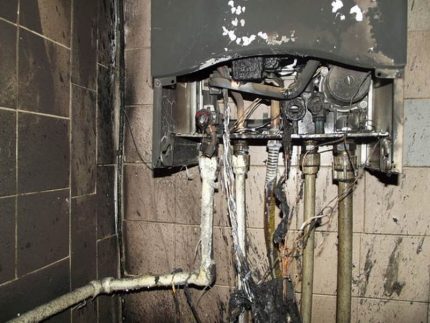
To determine such an abnormal receipt of "blue fuel" in the room, you can by the specific smell in the air. Then you should immediately close the valve with gas, ventilate the house and call gas specialists. And no use of matches or lighters, as well as the inclusion of electrical switches, calls, telephones, etc. until fully aired.
All gas boilers, heaters and stoves are divided into two categories - electricity-dependent and not. The former are more practical, safe and effective.But the latter will work even in the event of a power outage.
Plus, when connecting volatile models, in addition to the general rules, the rules of the PUE should also be taken into account. Without RCD It is forbidden to connect them to the electric network.
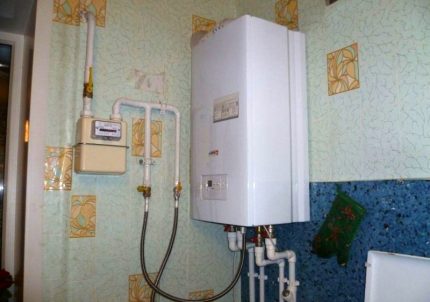
It is forbidden to hang a wall-mounted version of a gas boiler, a column, on a wall made of drywall or other soft material. Proper mounting reliability wall mounted gas equipment in this situation, it is impossible to provide. And any sagging or falling of the device on the gas is a rush of pipes and an accident with an explosion.
In individual and multi-apartment buildings up to 5 floors high, it is allowed to set atmospheric gas boilers with an open combustion chamber. If the building is of a higher number of storeys, then gas equipment in it is allowed to be mounted only provided that it is equipped with a closed sealed combustion chamber.
Air and speaker room
For a gas boiler to run smoothly, it needs a constant supply of new air. Without oxygen, methane, propane and butane will not burn. One gas fuel is not enough for proper and safe operation of the equipment in question.
Ventilation in the room for a gas heating device must provide sufficient air exchange. For a boiler with a capacity of up to 25 kW, a natural flow of air through the windows, vents and doors is enough. But if the equipment is more powerful, then it will have to build a supply ventilation system with compulsion.
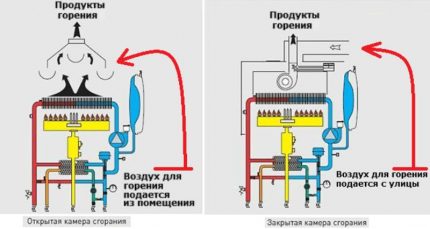
Generation of 1 kW of thermal energy in a gas boiler requires about 0.12 m3 natural gas and about 1.2 m3 air. These figures should be taken into account when calculating the required oxygen demand, as well as the fuel itself.
GOSTs for a boiler room or a room with a gas boiler set the following rules for the operation of equipment:
- Minimum 3x air exchange / hour.
- An inflow of about 10 cubic meters of air per cubic meter of gas burned for its complete combustion.
The more powerful the gas equipment, the more air it requires for efficient, high-efficiency operation.
The gas boiler room must be:
- non-residential - boiler room, kitchen, utility room, basement, room in the basement;
- with a ceiling height of 2.2 m and a volume of 8 m3 with a closed combustion chamber (height from 2.3 m and volume from 9 m3 with the camera open);
- with a window that has an opening sash or window;
- with natural ventilation system.
At the same time, it is allowed to install and use a gas boiler in the kitchen only if it has a capacity of less than 60 kW.
Combustion products
The chimney from the boiler is not allowed through the living quarters. Ideally, the pipe from the column should go directly through the outer wall. But with a small power of the heating device and when using a cooking stove, ventilation is permissible to organize through an ordinary common house ventilation duct.
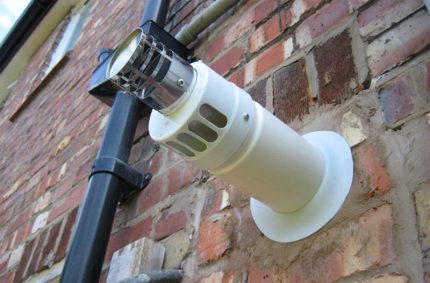
According to the rules of use and fire safety requirements, a gas boiler in a residential building may only be operated if it is factory-made. Homemade products can not be connected to the gas pipeline and cylinder with LPG.
The chimney from the gas column is made:
- from non-combustible materials that are not subject to active corrosion;
- without narrowing along its entire length;
- with a maximum of three turns;
- with a hatch for cleaning and a tap below for draining condensate;
- with a conclusion above the roof ridge for traction.
For powerful boilers, they are usually equipped with forced ventilation with additional air discharge. But if the device is designed to work with a coaxial smoke exhaust pipe, then it is permissible to refuse forced flow. The two-pipe chimney is already designed for sufficient air exchange in both directions - both to and from the furnace.
Cylinders, fittings and pipelines
Before you start using the newly installed gas boiler, you should check the tightness of all joints of the gas pipeline. To do this, it is enough to moisten the joints with soapy water, and then slightly open the gas. If it seeps into the room, the soap will begin to bubble.
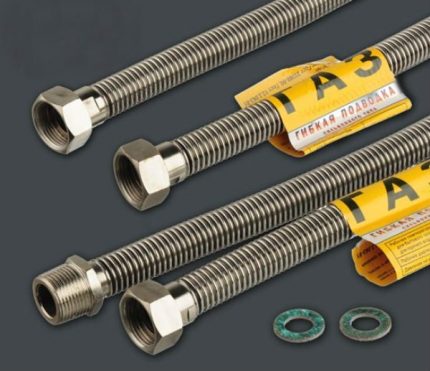
It is important to make sure that gas hoses not found to be transferred or overly stretched. Unused cylinders (empty and filled) are required to be kept safe with a gas appliance. And the used one should be placed so that direct sunlight does not fall on it.
Inside the private house, the rules are allowed to place cylinders for LPG with a capacity of up to 50 liters. If a gas holder is mounted, then it must be at least 10 m from the cottage. All pipes from it must be visible, cover them with decor or lay hidden gates in the selected walls for finishing.
Also, the boiler itself cannot be installed in niches or inaccessible place. It is possible to cover it with non-combustible decorative structures, but access to the device, gas valves, meters and control system elements should be unhindered.
Any work near the column, cylinder, gas pipe or chimney should be done after the gas is shut off. And then turn on the equipment again for heating is allowed only after a thorough check.
Safe operation of the gas boiler
Methane is lighter than air, and propane (LPG), on the contrary, is heavier. With a leak, the first rises to the ceiling, and the second falls to the floor. In order to exclude a dangerous concentration of gas and to avoid an explosion, it is necessary to provide natural ventilation in the first case with the exhaust hole at the top, and in the second with the air in the bottom of the wall.
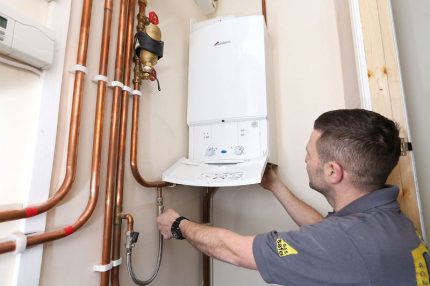
When cleaning, only non-aggressive detergents should be used to clean and wash the column outside. Also, do not use abrasive powders and coarse brushes.
To avoid problems when operating a gas boiler, you should:
- Only purchase a device and fittings from a trusted company.
- All equipment should be installed exclusively at the factory.
- Initial installation and connection of the column is to be delegated to the masters of the gas service serving the house or village.
- Regularly inspect the boiler for corrosion and destruction, as well as carry out a full technical check at least once a year.
- Ensure sufficient air exchange (with a small air flow or with a poor exhaust hood, the burner in the combustion chamber may go out).
- Avoid placing any foreign objects on the gas appliance.
- Constantly in order to avoid overheating of the unit, monitor the level of coolant and water in the boiler.
- For a volatile boiler, provide an uninterruptible power supply with a capacity of at least 12 hours and a separate line with an RCD.
- It is imperative to connect any gas equipment to the ground loop.
In addition to the built-in automation, it is recommended to install various security systems that shut off the gas supply when identifying certain problems.
The law does not require the installation of methane (propane) leakage sensors in rooms with a boiler.But with all safety rules, their installation is highly recommended.
Conclusions and useful video on the topic
Rules for the use of gas in the home:
Requirements for the operation of gas appliances:
On the safety of using gas equipment:
Even in the slightest degree, neglecting building codes, operating rules and fire safety requirements when using a gas boiler is not possible.
To avoid emergency situations, you must constantly monitor both the technical condition of the column and the tightness of the gas pipeline connections and the absence of clogging in the chimney. Only if all the above recommendations are followed, will it be possible to talk about the safe operation of the gas heating system.
Please write comments, ask questions, post a photo on the topic of the article in the block form below. Tell us how you comply with the requirements for safe and trouble-free operation of a gas boiler. Share useful information.

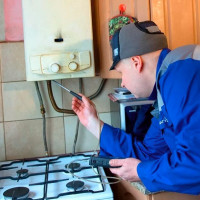 Rules for the operation of gas equipment in residential buildings: measures and standards for safe use
Rules for the operation of gas equipment in residential buildings: measures and standards for safe use 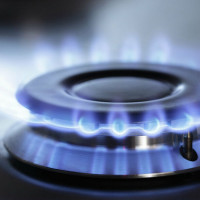 Fire safety of gas equipment: rules and regulations for the operation of gas appliances
Fire safety of gas equipment: rules and regulations for the operation of gas appliances  Is it possible to hang a microwave over a gas stove: safety requirements and basic installation rules
Is it possible to hang a microwave over a gas stove: safety requirements and basic installation rules 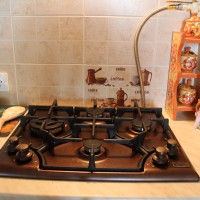 Distance from gas equipment to electrical wiring: technical regulations
Distance from gas equipment to electrical wiring: technical regulations 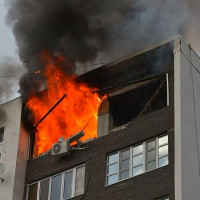 Can a gas column explode: why the threat arises and how to prevent it
Can a gas column explode: why the threat arises and how to prevent it 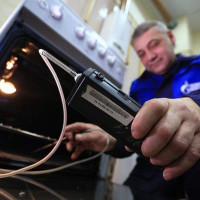 Gas inspection in an apartment: how and how many times gas equipment inspections should be carried out
Gas inspection in an apartment: how and how many times gas equipment inspections should be carried out  How much does it cost to connect gas to a private house: the price of organizing gas supply
How much does it cost to connect gas to a private house: the price of organizing gas supply  The best washing machines with dryer: model rating and customer tips
The best washing machines with dryer: model rating and customer tips  What is the color temperature of light and the nuances of choosing the temperature of the lamps to suit your needs
What is the color temperature of light and the nuances of choosing the temperature of the lamps to suit your needs  Replacement of a geyser in an apartment: replacement paperwork + basic norms and requirements
Replacement of a geyser in an apartment: replacement paperwork + basic norms and requirements